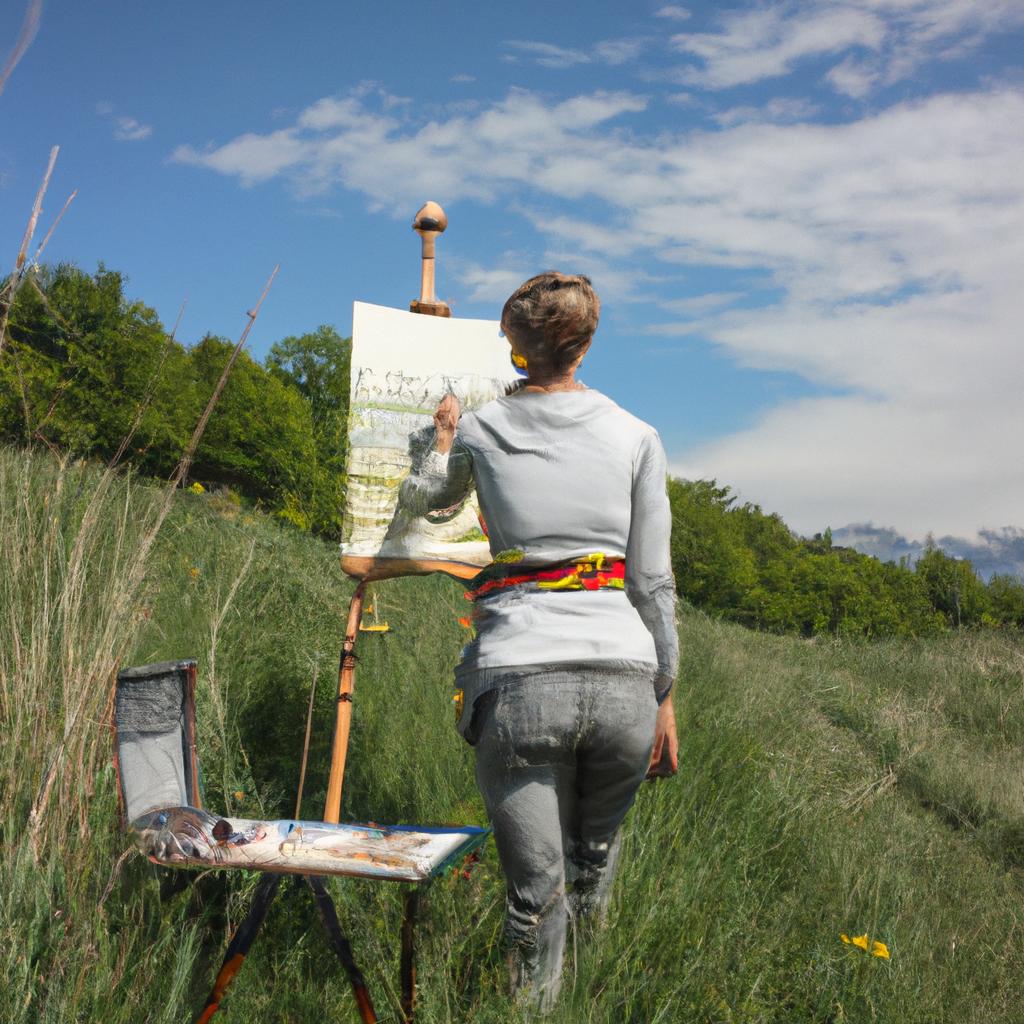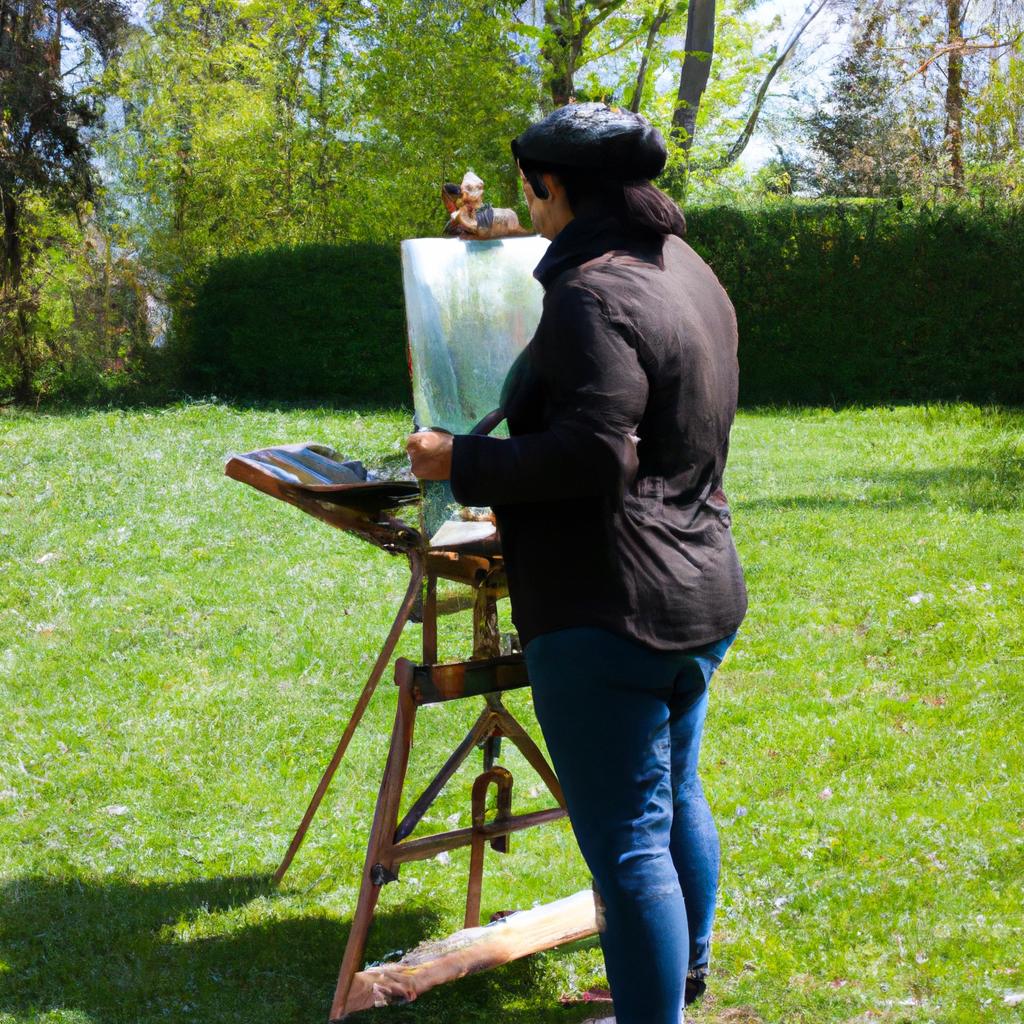Landscape paintings have long been revered for their ability to capture the beauty and essence of nature. From the intricate brushstrokes of Monet’s “Water Lilies” to the vibrant colors of Van Gogh’s “Starry Night,” these artworks transport viewers into serene worlds filled with rolling hills, majestic mountains, and tranquil rivers. However, landscape art has not only flourished on canvas but also made its mark in the world of cinema. For instance, Martin Scorsese’s acclaimed film “The Revenant” transports audiences to the rugged landscapes of 19th-century frontier America through breathtaking cinematography and meticulous attention to detail.
In both arts and movies, landscape paintings serve as a powerful medium that captures the raw emotions evoked by natural surroundings. They provide an opportunity for individuals to immerse themselves in scenes they may never have encountered otherwise—whether it be standing before a cascading waterfall or gazing at an expansive sunset over vast plains. These masterpieces offer a glimpse into untouched terrains, inviting contemplation and introspection within their viewers. Moreover, landscape paintings create a connection between humanity and nature; they remind us of our place within the larger ecosystem while simultaneously inspiring awe and reverence for Earth’s wonders.
While traditional landscape paintings freeze While traditional landscape paintings freeze a particular moment in time, cinematic landscapes have the advantage of motion and sound. Through skilled cinematography, filmmakers can capture the grandeur and dynamism of natural settings, transporting viewers into immersive worlds where they can witness the changing seasons, shifting light, and flowing waters. The use of wide-angle shots and sweeping camera movements allows for a sense of scale and depth that enhances the viewer’s experience.
Furthermore, films often utilize sound design to further enhance the impact of their landscapes. The rustling of leaves, the crashing waves, or the howling wind all contribute to creating a multisensory experience that amplifies the emotional response elicited by these environments. In combination with visual storytelling techniques such as color grading and composition, cinematic landscapes have the power to evoke strong emotions within audiences.
Both landscape paintings and cinematic landscapes serve as windows into nature’s beauty and offer an escape from our daily lives. They provide us with moments of tranquility and contemplation, reminding us of the vastness and magnificence of our planet. Whether it is through static brushstrokes on canvas or moving images on screen, these artistic representations allow us to connect with nature in profound ways.
The Evolution of Landscape Depictions
Landscape paintings have long captivated artists and audiences alike, with their ability to convey the beauty and grandeur of nature. Throughout history, these artworks have evolved in style and technique, reflecting not only changes in artistic movements but also shifting perspectives on the natural world. One example that illustrates this evolution is Claude Monet’s famous series of haystacks painted during the late 19th century.
During this period, Impressionism emerged as a new artistic movement characterized by its emphasis on capturing fleeting moments and atmospheric effects. Monet’s haystacks series exemplifies this approach, as he sought to depict variations in light and color throughout different times of day and seasons. The use of loose brushstrokes and vibrant colors evokes a sense of immediacy and suggests an intimate connection between the artist and his subject.
To further emphasize the emotional impact of landscape art, consider the following bullet points:
- Awe-inspiring vistas: Mountains rising majestically against a clear sky.
- Serene seascapes: Calm waters reflecting the soft hues of sunset.
- Tranquil forests: Sunlight filtering through a canopy of lush green leaves.
- Vast plains: Endless horizons stretching out into infinity.
Additionally, a table can be used to highlight key differences in landscape depictions across various artistic periods:
| Artistic Period | Style | Characteristics |
|---|---|---|
| Renaissance | Idealized | Balanced compositions; meticulous details |
| Romanticism | Sublime | Dramatic scenes; awe-inspiring landscapes |
| Realism | Truthful | Accurate representation; everyday subjects |
| Modernism | Abstracted | Simplified forms; experimental techniques |
As we delve deeper into the realm of landscape art, it becomes evident that nature has been more than just inspiration for artists – it has also served as a powerful influence on filmmakers. The subsequent section will explore how cinematic representations of the natural world have evolved alongside their painterly counterparts, highlighting the ways in which artists and filmmakers draw from nature’s vast palette to create evocative imagery that speaks to our senses.
The Influence of Nature on Artists and Filmmakers
The Evolution of Landscape Depictions in arts and movies has paved the way for a deeper exploration of nature’s beauty. From traditional landscape paintings to modern cinematic portrayals, artists and filmmakers have continuously found inspiration in the breathtaking landscapes that surround us. One noteworthy example is Claude Monet’s series of haystacks, where he captured the changing light and atmosphere throughout different times of day.
When examining the influence of landscape on artistic expression, several factors come into play. Firstly, the use of color plays a significant role in portraying emotions and evoking certain moods within viewers. For instance, warm colors like reds and oranges may create a sense of warmth or passion, while cool blues and greens can convey tranquility or serenity.
Furthermore, composition also holds considerable importance when it comes to depicting landscapes effectively. The arrangement and placement of various elements within the frame can guide the viewer’s gaze and establish a visual hierarchy. A well-composed landscape painting or movie scene can lead the audience’s eyes from one point of interest to another, allowing them to appreciate every detail carefully.
In addition to color and composition, texture adds depth and realism to artworks featuring landscapes. Whether it be through brushstrokes in paintings or intricate details in film sets, textures help bring these scenes to life by engaging our senses. By incorporating roughness or smoothness into their works, artists and filmmakers enhance the overall aesthetic experience for viewers.
To further emphasize the emotional impact that landscapes can have on audiences, consider the following bullet points:
- The vastness of open fields under an endless sky creates a feeling of freedom.
- Glimmers of sunlight breaking through dense forest foliage evoke a sense of mystery.
- Majestic mountain ranges inspire awe and reverence.
- Serene coastal vistas with gently crashing waves induce calmness and relaxation.
Additionally, let us explore how different aspects such as color, composition, and texture contribute to creating emotionally resonant landscapes by referring to the following table:
| Aspect | Emotion Evoked |
|---|---|
| Color | Warmth |
| Composition | Tranquility |
| Texture | Realism |
As we delve deeper into the symbolism of landscapes in visual arts, it becomes evident that these depictions hold significant meaning beyond mere aesthetics. The intricate relationship between nature and artistic expression continues to captivate artists and filmmakers alike, inspiring them to convey their personal interpretations through various mediums.
Transitioning into the subsequent section about “The Symbolism of Landscapes in Visual Arts,” we begin to unravel a new layer of insight into how landscapes can be used as powerful symbols within different creative contexts.
The Symbolism of Landscapes in Visual Arts
Landscapes have long been a subject of fascination and inspiration for artists and filmmakers. They serve as powerful symbols that evoke emotions, tell stories, and convey deeper meanings beyond their physical appearance. This section explores the symbolism behind landscapes in visual arts, shedding light on how artists use nature to convey their messages.
One example of landscape symbolism can be found in Vincent van Gogh’s famous painting “Starry Night.” In this masterpiece, Van Gogh depicts a swirling night sky above a small town with cypress trees. The turbulent brushstrokes and vibrant colors create an intense emotional atmosphere. The starry sky serves as a symbol of hope and dreams, while the darkened village represents the struggles and challenges faced by humanity.
To further understand the symbolic power of landscapes in art, let us explore some common themes often associated with these representations:
- Tranquility: Calm and serene natural scenes create a sense of peace and tranquility.
- Isolation: Lonely or desolate landscapes can represent feelings of isolation or alienation.
- Transformation: Changing seasons or weather conditions can symbolize personal growth or transitions in life.
- Harmony: Balanced compositions highlighting the harmony between man-made structures and nature can signify unity.
In addition to thematic symbolism, visual artists also employ various techniques to enhance the meaning conveyed through landscapes. One such technique is color symbolism – using different hues to evoke specific emotions or associations. For instance, warm tones like reds and yellows may suggest energy or passion, while cool blues might elicit feelings of calmness or melancholy.
| Theme | Associated Emotion |
|---|---|
| Tranquility | Peaceful |
| Isolation | Loneliness |
| Transformation | Growth |
| Harmony | Unity |
Through meticulous composition choices and skillful manipulation of artistic elements, creators are able to imbue landscapes with profound symbolism. These symbolic representations provide viewers with an opportunity to explore and interpret the meaning behind the artwork in a personal and subjective manner.
As we have delved into the symbolism of landscapes, it becomes evident that artists employ various styles to represent nature’s beauty. Exploring Different Styles of Landscape Representation allows us to appreciate the diversity within this genre while uncovering new perspectives on our surroundings.
Exploring Different Styles of Landscape Representation
Landscape paintings have long been appreciated for their ability to capture the beauty and tranquility of nature. In visual arts, landscapes are often used symbolically to convey a range of emotions and ideas. The previous section explored the symbolism behind landscape paintings, highlighting how artists use elements such as color, composition, and perspective to evoke specific feelings in viewers.
Now let us delve into the different styles of landscape representation that artists employ to bring these natural wonders to life on canvas. One noteworthy example is the Impressionist movement, which emerged in the late 19th century. Artists like Claude Monet sought to capture fleeting moments and atmospheric effects through loose brushstrokes and vibrant colors. Through this innovative approach, they aimed to depict not only what they saw but also how they perceived it emotionally.
To further understand the various ways in which landscapes can be represented, consider the following aspects:
- Scale: Landscapes can be depicted on both grand and intimate scales, allowing artists to create different moods and sensations.
- Lighting: Manipulating light sources within a landscape painting can dramatically influence its overall mood and atmosphere.
- Seasonal variations: By depicting different seasons – from lush greenery in springtime to snowy scenes in winter – artists can evoke nostalgia or highlight the cyclical nature of life.
- Human presence (or absence): Including human figures or structures within a landscape serves as a way for artists to explore our relationship with nature or comment on societal issues.
The table below illustrates how these aspects contribute to diverse representations of landscapes:
| Aspect | Effect | Example |
|---|---|---|
| Scale | Conveys vastness or intimacy | A panoramic view versus an up-close detail |
| Lighting | Sets tone and creates depth | Soft morning glow versus harsh midday sunlight |
| Seasonal variations | Elicits emotional responses | Vibrant autumn foliage versus serene summer scenes |
| Human presence | Explores human-nature dynamics | A solitary figure in a vast landscape versus an urban skyline |
Understanding the various styles and techniques employed by artists to represent landscapes allows us to appreciate their skillful interpretation of nature’s beauty.
[Transition] With this understanding of different landscape representation approaches, let us now turn our attention to notable examples where landscape paintings played pivotal roles within movies.
Famous Landscape Paintings in Film History
Exploring Different Styles of Landscape Representation has provided insight into the various artistic approaches used to depict natural scenery. Now, let us delve further into the realm of landscape representation by examining some famous landscape paintings in film history. One such example is the iconic painting “Starry Night” by Vincent van Gogh.
“Starry Night,” painted in 1889, showcases Van Gogh’s unique style characterized by bold brushwork and vibrant colors. This masterpiece captures a sense of movement and emotion through swirling skies and expressive brushstrokes. Its inclusion in films like Woody Allen’s “Midnight in Paris” highlights the enduring impact of this artwork on popular culture.
Landscape paintings have not only served as inspiration for filmmakers but also played significant roles within movies themselves. They contribute to establishing atmosphere, conveying emotions, or even representing specific time periods or locations. To better understand their significance, consider the following bullet points:
- Landscape paintings can evoke nostalgia, transporting viewers back to a particular era or setting.
- They can create a sense of awe and wonder, immersing audiences in the grandeur of nature.
- These artworks often serve as visual metaphors, symbolizing characters’ inner states or reflecting narrative themes.
- The use of well-known landscape paintings in films can enhance storytelling by adding layers of meaning and cultural references.
To illustrate this point further, let us examine three notable instances where landscape paintings have been featured prominently onscreen:
| Film | Painting | Significance |
|---|---|---|
| “The Da Vinci Code” | “Mona Lisa” | The enigmatic smile portrayed in da Vinci’s masterpiece becomes a key clue that unravels the film’s mystery plot. |
| “Titanic” | “Sunset over Montmajour” | This painting represents Rose’s longing for freedom and her desire to escape societal constraints aboard the ship. |
| “The Thomas Crown Affair” | “Impression, Sunrise” | Monet’s painting serves as a metaphor for the protagonist’s desire to break free from his mundane existence. |
As we can see, landscape paintings in film offer more than just visual appeal; they enrich storytelling and elicit emotional responses from viewers.
In exploring famous landscape paintings in film history, it becomes evident that these artworks have a profound impact on both artistic mediums. The meditative power of landscape art will be further explored in the subsequent section, highlighting how these representations can evoke introspection and tranquility within audiences.
The Meditative Power of Landscape Art
While landscape paintings have long been appreciated for their aesthetic beauty, they also possess a unique ability to evoke a sense of tranquility and introspection within the viewer. By capturing the essence of nature’s majestic landscapes on canvas, artists are able to transport us into a serene world where we can temporarily escape the chaos of everyday life. This transformative power is not limited to visual arts alone; it has also found its way into the realm of cinema, as filmmakers recognize the impact that breathtaking natural scenery can have on storytelling.
Consider, for instance, the film “The Revenant” directed by Alejandro González Iñárritu. In this Oscar-winning masterpiece, the vast wilderness serves as both backdrop and character in itself. Through sweeping shots of untouched mountains, dense forests, and frozen rivers, viewers are drawn into an immersive experience that mirrors the protagonist’s journey through harsh terrain. The use of stunning landscape cinematography not only enhances our emotional connection with the story but also allows us to appreciate nature’s raw beauty and unforgiving power.
This meditative power of landscape art extends beyond mere visual stimulation. Research suggests that exposure to natural environments can have therapeutic effects on mental well-being. Here are some ways in which landscape art promotes a sense of calmness and self-reflection:
- Sense of awe: Immersing ourselves in vast landscapes depicted in art or film instills a feeling of awe and wonderment that can momentarily transcend our daily worries.
- Connection with nature: Viewing depictions of natural settings helps us reconnect with the natural world even when urban living keeps us distanced from it physically.
- Emotional release: Experiencing tranquil landscapes allows for emotional release, providing solace during times of stress or turmoil.
- Contemplation and mindfulness: The stillness inherent in many landscape artworks invites reflection and encourages moments of mindfulness.
To further explore how different elements within landscape art contribute to its meditative power, let us consider the following table:
| Element | Description | Emotional Response |
|---|---|---|
| Color palette | Soft and muted tones | Calmness |
| Composition | Balanced and harmonious arrangement | Serenity |
| Lighting | Gentle, natural lighting | Tranquility |
| Texture | Subtle brushstrokes or fine details | Comfort |
Through a careful combination of these elements, artists are able to create works that not only capture the beauty of nature but also evoke emotional responses within their audience. This ability to transport viewers into a state of tranquility is what makes landscape art such a powerful medium.
In conclusion, landscape paintings and their portrayal in films have a profound impact on our emotions and well-being. By immersing ourselves in these depictions of nature’s grandeur, we can experience moments of serenity and introspection. Through the use of color palettes, composition techniques, lighting choices, and textures, artists craft visual narratives that instill awe, foster connection with nature, provide emotional release, and prompt contemplation. The transformative power of landscape art lies in its ability to transport us from the chaos of everyday life into a peaceful realm where the beauty of nature takes center stage.




